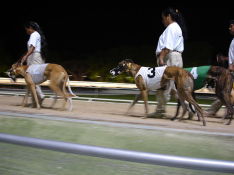Will greyhound racing ever get back on track?
 Following the expose of blooding and other practices in greyhound racing last week Damian Madden looks at what the sport needs to do to regain public trust.
Following the expose of blooding and other practices in greyhound racing last week Damian Madden looks at what the sport needs to do to regain public trust.
As an animal lover, and somebody who has been to the dog track occasionally, I was abhorred when I saw the Four Corner’s footage earlier this week of greyhound trainers ‘blooding’ their dogs using live animals.
Watching the fallout in the days that followed I began to wonder if greyhound racing could recover from this catastrophic blow. Has its brand been damaged beyond repair?
What the people involved did was inexcusable, inhumane and indefensible. This post isn’t intended to excuse them or ‘make good’ what is truly a horrible crime. I’m focusing here on the overall brand – looking at its positioning before, during and after this revelation – because it offers valuable insights that other brands can learn from.
Greyhound racing in Australia has long courted controversy with fresh claims of cruelty, over-breeding and other incidents never too far away. The sport’s very beginnings featured dogs chasing and trying to kill live animals.
Yet despite this it’s become big business and 12,000 people around the country depend on it for their livelihood. So calls for a total ban will probably fall on deaf ears and rightly so. However, it’s always had a branding problem and that’s coming to the fore right now as the industry faces its toughest challenge yet. This demonstrates the importance of not doing anything until you have your brand right.
Response to the Four Corners broadcast from within the industry has been cautious at best. Yes those directly implicated by the footage have been stood down, and task forces have been created, but you get the impression that there’s hesitation. If greyhound racing in this country is to recover, those within the sport itself need to get on the front foot.
This is basic crisis management and although I’m sure they’re not being completely inactive, they’re not doing enough in the public eye and it has been others associated with racing more generally (like Peter V’Landys) who have had to do it. Ultimately, convincing the public that things will be different from now on is vital if the industry is to regain acceptance.
The first obvious step in any brand-mending process is cleaning up what happened. Greyhound racing needs broad and easy to understand reform clearly communicated to the wider public through effective and engaging content. The sport’s image is rough and ready so it doesn’t have the polished corporate structure to make a case for the defence. Establishing this structure and sense of accountability will be crucial.
It’s also important that those in charge maintain focus on fixing things; they can’t just turn a blind eye (as some have suggested they have been doing) hope that this will blow over or question whether the footage was obtained legally because it doesn’t matter in terms of public perception. They also cannot draw comparisons to events like the Fine Cotton ring-in scandal of the 1980s, which has generally now been accepted as a colourful chapter in horse racing’s folklore. This is very, very different. The public needs to have faith that greyhound racing’s controlling body can actually exert authority.
Once the live-baiting issue has been cleared up it should turn attention to another issue that has plagued the industry for years – dog cruelty.
Greyhound racing desperately needs to put together a proper corporate narrative; a brand story people can relate to. It doesn’t have one today and that has been painfully obvious during this scandal. A corporate narrative, the essence of your business in action, is drawn from the key elements that make your brand work – the vision, behaviour, themes and so on.
Having a strong narrative helps you handle whatever comes your way in a fashion that’s in keeping with the ideals that drew customers to your brand in the first place. This is how some brands emerge from difficult circumstances with their customer base intact and, what’s more, having given them a glimpse into how they handle situations with dignity and respect. These are admirable qualities in brands, just as they are in people.
Greyhound racing is sometimes positioned as family entertainment but, having stood on the concrete steps at Wentworth Park more than a few times, I can honestly say I’ve never seen a family enjoying the action. You’d need a great imagination to conjure up any sort of family ‘vibe’.
The corporate branding is all at sea, which is in keeping with how the live-baiting issue has been handled so far. For a recent example of how a strong corporate narrative can help in a crisis look at the horse-death controversy that marred last year’s Melbourne Cup. Horse racing has a much stronger narrative and dealt with the situation in a way that was in keeping with its brand. It may not be completely resolved, and animal rights groups still have questions, but in terms of public perception it was, by and large, handled.
This brings me onto my last point – rebranding. Greyhound racing needs to do it, badly. If the sport is going to recover and grow, rather than reverting back to the support of its ageing faithful, there’s some serious work ahead. Part of this will be showcasing a newfound transparency demanded by the public as to the welfare of the dogs and the complete stamping out of live-baiting.
For a long time greyhound racing has been viewed very poorly by the wider public but it doesn’t have to be that way. This is a business based around animals so their welfare should be at the centre of everything. Beyond that, I’d start shifting focus away from the track and work on improving the environment around it. Today’s crowd goes solely to gamble but giving people other reasons to be there, to enjoy a meal and a couple of drinks, would be a starting point.
There has to be a world more people want to be part of before you can stage any meaningful recovery. This is the only way to bring in new audiences and without those the sport’s days are numbered.
- Damian Madden is group creative & social director at Spectrum Group



No there’s nothing they can do. Any time you bring animals, paid entertainment and gambling together, greed leaves the animals worse off.
There’s all sorts of ‘entertainment’ from years past that we no longer find acceptable. Greyhound racing itself is illegal in many countries.
It’s day is done.
Hey editor, there are some Crimes Against Grammar in this blog post that shouldn’t have made it past your red pen.
“I was abhorred”
“Greyhound racing in Australia has long courted controversy”
Good lord. The author means the opposite of what he’s writing.
Nana
Have a look at the win betting pools for the dogs on tab.com.au. I haven’t run the numbers, but after perusing a few weeks results, I would say the numbers are not down that much, if at all.
Clearly most of the people expressing outrage over this do not contribute to greyhound racing’s bottom line anyway, so the business will go on until it is banned.
The LARGE majority of people expressing ‘outrage’ have no financial influence on the sport. Live baiting has gone on for decades upon decades. Yes, it has been outlawed and the majority in the industry WOULD report anyone that they knew was doing such a thing these days, but just like with the cobalt issues in Horse Racing recently, there are always a few bad eggs. Betting on the greyhounds won’t decrease and hasn’t if you look at the numbers.
Yes, a few sponsors have pulled out, but in the end, it’s the gambling $$$ that keeps the sport going. The industry needs to take a good hard look at itself and bring in an independent body (not one they are pulling the strings off) to over-see an Australia wide review.
I watch my butcher as they hack the meat up and I still eat beef?!
This entire “case study” is a bit daft… as an animal lover, you’ve been to the races & you’re a bit outraged at what has been uncovered about the “sport”?…
Come on, using this as a case study for re-branding is about as relevant as using slavery, apartheid, people trafficking, or any number of cruel animal “sports” like cock or bull fighting. “Can the whites regain ultimate power!?”, “Will we be able to take the vote back from women!?”, “Can we make it look like the bulls enjoy the game!?”.
It’s not the brand or branding that’s the problem, it’s the existence of the industry as a whole. Hopefully I have kids one day who can look back & say “Wait, that used to be okay to do?”.
Hi there, I’m really confused as to why this is being used as a case study. Any industry (I refuse to call it a sport when the athletes participating get killed when they are injured) that results in 9 out of 10 dogs dying when they ‘retire’ needs to be banned full stop. As Suzanne says, this is akin to saying that the branding of the cock fighting industry is the problem and not the industry itself.
How about we do a last minute swap with the Indonesian govt. We give them the trainers who laughingly watched possums being torn to pieces – and they give us back our reabilitated drug smugglers.
Yes it will, I personally would be surprised to see much of a decline in revenue at all – Public opinion is a different story but at the end of the day greyhound racing isn’t exactly a sport that anyone cares about too much other than those in it.
Horse racing would be a different story because there is such a huge casual interest by many Australians because going to the races is more of an event for most rather than a punt.
The dog’s are strictly for punters and they will not stop punting because of a issue like this.